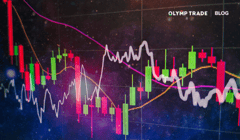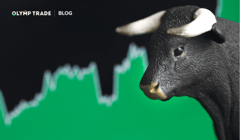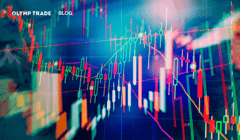
The S&P 500 grew another 1.3% during the session. During the last two weeks, it’s the sixth time the index has grown more than 1% in a day. Such market optimism may be short-lived. The situation around Ukraine and inflation concerns are making these already aggressive monetary policy measures even worse. Read on to find out how you can best orient yourself in today's market conditions.
Interact with the dashed blue word and green spot on images to get additional details and explanations.
More details on the visuals will be here.
A term definition or explanation will be here.
Contents
Weekly Trends
Nvidia ↑+6.42%
Trading up with a $100 and X20 multiplier could have been worth $128.40.
CAD/JPY ↑+2.72%
Buying this currency pair with a $100 and an X500 multiplier could earn you $1360.
BTC/USD ↑+6.55%
Buying Bitcoin with a $100 and X10 multiplier would earn you $65.50.
Currency Markets
JPY Pairs Might Offer Trade Opportunities
Last week, the US dollar stayed relatively flat. While key currencies rose against the USD, the case of the Japanese yen is worth looking at.

In the long term, the JPY has been depreciating against most currencies. Partly, it was a result of the actions of the Japanese financial authorities. One of the reasons is that Japan is a net exporter of goods and services, and when domestic currency’s lower value is usually thought to act as a premium to exporters. Before, the Japanese authorities admitted that they intentionally tried to do that. Later, when the former US President Donald Trump directly raised this fact before them, they denied it. Now, they might be fighting for this monetary competitive advantage once again.
This offers ample opportunities for JPY traders. For example, CAD/JPY may be significantly overstretched, and it cannot keep growing forever. Therefore, we believe, there will likely be a big correction on the way. Also, this pair’s market movement is usually regular and fundamentally driven. However, it now seems to be more cyclical or momentum-driven. That’s why when CAD/JPY shows signs of a reversal, selling it may be a good idea.

Expected level of correction
US Fed’s Plan on Inflation
At the beginning of the year, the Federal Reserve was hawkish. Now, it has become even more so. The CME FedWatch tool indicates that they might raise rates by 50 basis points during the May 4th meeting with the probability of 70.5% and by another 50 basis points in June. That would be an aggressive move. Moreover, the members who were dovish before, Evans and Kashkari, have changed their vision. That means the USD will likely rise in the near future and the US stock market will be under more pressure.

The Fed is not alone in being hawkish. Other central banks are planning to tighten their money supply and raise interest rates, too. On March 24, the Bank of Mexico raised rates by a surprising 50 basis points against the forecast of 25 b.p. Keen traders were not surprised as the announcement came from President López Obrador first, and from the bank after. During his early morning press conference, the Mexican President said that the bank would hike rates substantially. That statement effectively undermined the official announcement and the independent status of the central bank.

19.83-19.85 Target
Next week, important economic data will be released. Among the key reports, there will be Non-Farm Payrolls, Confidence figures, inflation data, and UK Retail Sales. While this data will be potentially impactful, the major motivator for markets will be risk trends. The S&P 500 and other stock indices reflect the investor sentiment’s dynamics well.
Stock Markets
US Stock Market
Growth-oriented statistics boosted the S&P 500, pushing it above its 200-day moving average. Pharmaceutical and IT stocks are at the core of the uptrend.
US indices are continuing the upward movement since last week, but the market enthusiasm is cooling. The PMI data released was 58.8, and the initial jobless claims dropped to 187K. This was a possible growth booster in the second half of the last week. The weekly results, however, are less impressive than the uptrend that began on March 15. Last week, the Dow Jones lost about 0.12%, the Nasdaq 100 rose by 2.14%, and S&P 500 grew by 1.28%. The volatility in the US indices was very high and consolidation has started. Pharmaceutical sector and tech stocks supported the market. AMD, Nvidia, Apple, and Facebook have grown surprisingly well.

The technical picture in the S&P 500 is two-sided. On the one hand, during last week, we saw engulfing patterns two times in a row. On the other hand, this pattern undermines the upward momentum and brings uncertainty. The markets rarely move based on technicals alone. Usually, there is a fundamental factor that brings volatility. We expect the index to stay sideways over the next few weeks.

Impact Factors
There are factors that can drag speculative markets lower. One of them is the Fed’s interest rate hikes that will likely drag the US stock market prices lower. It happened many times before when they began their rate-hiking cycles and usually resulted in regressing markets.
Moreover, the sanctions put on Russia and Belarus will echo across the world. Many sectors of the European economy will likely be hit by counter-sanctions and a lack of demand from their 5th trading partner by size. The effect may also reach the US. Over there, gas prices are rising, and the businesses’ withdrawal from the region brings a loss of potential income.
Generally, the uncertainty in the behavior of the world indices suggests trading them with caution and expecting possible downward movements.
Despite all the negativity, tech companies are showing a massive spike in price. Due to the shortage of microchips in the world economy and increased demand the stock prices of AMD and Nvidia are growing fast. Nvidia grew by 9.82% in one day last week. They underwent a stock split of 4:1 on July 20, 2021. Since then, the stock has resisted the decline of the US stock market and now seems poised to grow. Outlined on the graph below, we show two levels that can be used as a take profit or target for bullish traders.

First level of support
Short term profit target
Mid term profit target
Commodity Markets
Oil and Gas Prices Surge as Energy Supplies Become a Weapon
The commodities markets continue to struggle as the conflict between Russia and Ukraine rages on with no end in sight. The United States and Great Britain are the main countries taking confident steps to ban Russian oil imports and setting pressure on the European Union to follow. European Union’s foreign ministers have not come to an agreement to join the energy sanction regime as the EU highly relies on Russian energy sources. Germany, Hungary, and the Netherlands are against the restriction of Russian oil and gas imports. On 24.03-25.03 western leaders, including U.S. President Joe Biden met for a triple NATO, G7 and EU summits in Brussels to discuss additional sanction packages against Russia.
Russian President Vladimir Putin announced his own retaliatory measures. Russia will now sell gas for Russian rubles to “unfriendly nations” that include Ukraine, all of the EU nations, the US, the UK, and Japan amongst others. What does this mean and how would this work? For one thing, receiving payments in rubles would support the national currency and likewise ease some sanctions, as governments would need banks to cooperate with for the currency exchanges, keeping in mind that many Russian banks have already been slapped with sanctions and operating restrictions on international levels. If payments are processed as previously, not in rubles, there is the possibility of disruption in supply, which would only drive the energy markets higher.
The price of Natural Gas skyrocketed following the news from Russia. On the Daily chart, Natural Gas broke a strong level of resistance at 5.315 and reached 5.470 as the next level of resistance. Further upside potential remains as tensions remain with the next target at 5.685.

Major resistance broken.
News from Russia.
Next potential resistance target.
Brent Oil Price is Recovering Fast from its Recent Drop Below $100
Oil and Gas are in the same boat of turmoil and volatility due to the conflict surrounding Russia, Ukraine, and sanctions. After the rather unexpected drop to trend line support the price of black gold continues to grow. The price broke above the 61.8% Fibo level but failed to secure. The most common scenario is that the price of Brent will remain high.

Trend Line Support.
61.8% Fibo level.
Last week, safe haven Gold was trading in a range following trend line support. The yellow precious metal has upside potential during mounting market uncertainty. The price broke out of the range above $1950 per troy ounce resistance. The outlook for gold is bullish.

Trend Line Support.
Broken resistance at $1,950.
Cryptocurrency Markets
Crypto Stocks Outperform Bitcoin – a Bullish Turn?
Over the past week, the top two crypto-currencies, Bitcoin and Ethereum, traded mildly bullish but at the end of last week broke through resistance. As of top news, Ethereum burnt, destroyed, and taken out of circulation $6 billion worth of its own cryptocurrency since last year. Goldman Sachs made the first over-the-counter crypto transaction by a major bank, making a big step in the development of crypto markets for institutional investors. Additionally, Bitwise Crypto Industry Innovators exchange-traded fund, BITQ, which tracks the performance of companies that generate the majority of their revenue from their crypto business activities outperformed Bitcoin which usually points to a bullish turn on the cryptocurrency markets.

The Fear and Greed index has climbed to 47 and is now in the Neutral state.

The global crypto market capitalization is $2.00T and the crypto market volume is $105.78B.
Ethereum Breaks $3,000. Is it too Late to Buy the Dip?
Last week Ethereum broke the down trend line from December 1, 2021, to the upside. On Thursday, March 24, the price broke above $3,000 for the first time since mid-February. After a re-test of the broken level, bullish momentum may bring the price to $3,285 followed by $3,400. Bitcoin is also making a slow but steady advance to the upside. But long positions should only be considered once the main cryptocurrency breaks above major resistance at $45,000.

Down Trend Line from 01.12.21
Broken Trend Line Resistance
Break above $3,000 Resistance
Risk warning: The content of the article does not constitute investment advice and you are solely responsible for your trading activity and/or trading results.
A engulfing pattern is a candlestick pattern that forms when a candlestick is followed the next day by an opposite color candlestick, the body of which completely overlaps or engulfs the body of the previous day’s candlestick. This pattern is thought to be a reversal pattern.
The North Atlantic Treaty Organization, also called the North Atlantic Alliance, is an intergovernmental military alliance among 28 European countries and 2 North American countries. Established in the aftermath of World War II, the organization implements the North Atlantic Treaty, signed 4 April 1949.
The Group of Seven is an inter-governmental political forum consisting of Canada, France, Germany, Italy, Japan, the United Kingdom, and the United States.
Economic sanctions are commercial and financial penalties applied by one or more countries against a targeted self-governing state, group, or individual. Economic sanctions are not necessarily imposed because of economic circumstances—they may also be imposed for a variety of political, military, and social issues.
Upside refers to the potential increase in value, measured in monetary or percentage terms, of an investment.
Volatility often refers to the amount of uncertainty or risk related to the size of changes in a security's value. A higher volatility means that a security's value can potentially be spread out over a larger range of values.
Black gold is an informal term for oil or petroleum.
Fibonacci retracement levels are horizontal lines that indicate where support and resistance are likely to occur.
A safe haven is an investment that is expected to retain its value or even increase in value, during times of market turbulence and uncertainty. Safe-haven assets offer protection from market downswings.
Range-bound trading is characterized by prices staying in a definable range over time.
An informal term for Gold.
The state of not knowing or a lack of. knowledge about the future direction of a given market.
Burning crypto means permanently removing a number of tokens from circulation. This is typically done by transferring the tokens in question to a burn address, i.e. a wallet from which they cannot ever be retrieved. This is often described as destroying tokens. A project burns its tokens to reduce the overall supply.
Over-the-counter (OTC) securities are traded directly between counterparties without being listed on an exchange.
An institutional investor is a company or organization that invests money on behalf of clients or members.
BITQ tracks an index designed with Bitwise’s industry expertise to identify the pioneering companies that generate the majority of their revenue from their crypto business activities.











